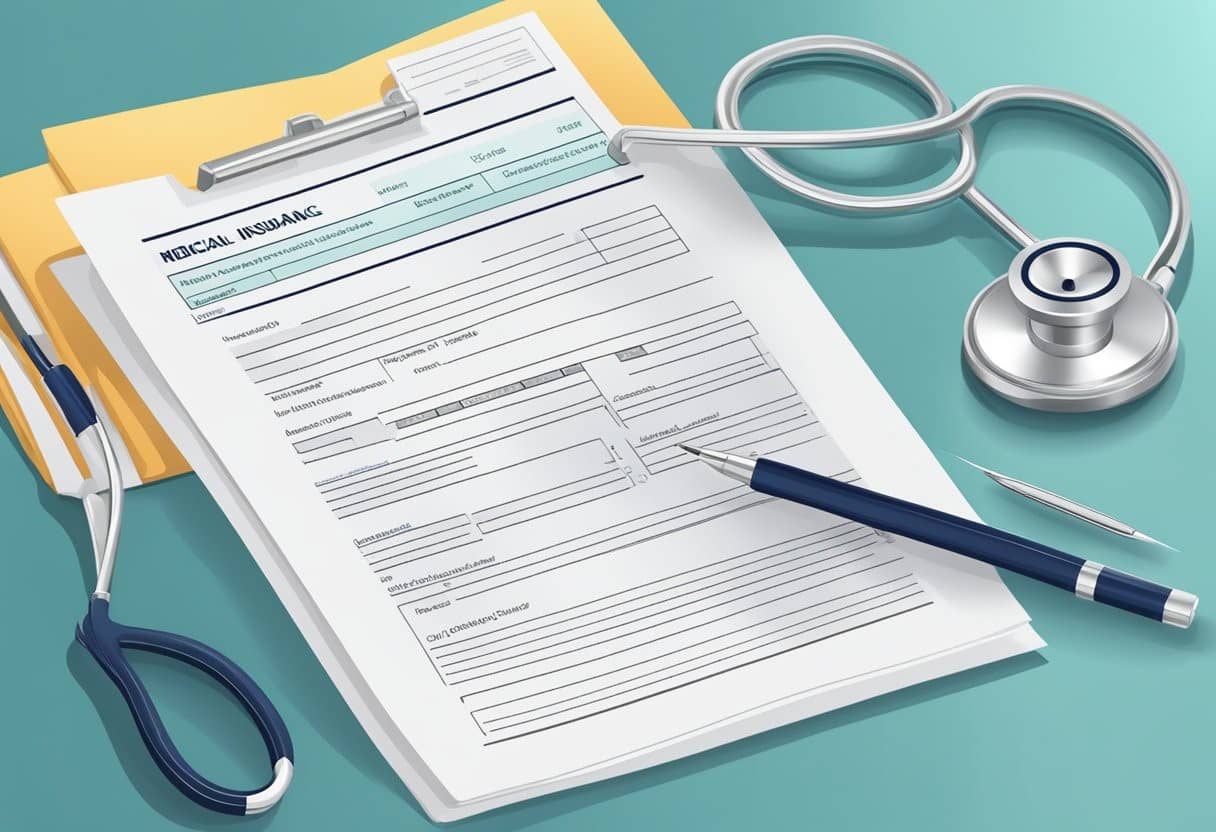Medical insurance is an essential component of financial planning, providing coverage for medical expenses that can be expensive and unexpected. Medical insurance plans offer financial protection against medical and surgical expenses, covering hospitalization, diagnostic tests, and other healthcare costs. It is important to understand the different types of health insurance and choose the right medical insurance plan that meets your needs.
The medical insurance claims process can be complicated and confusing. Policyholders need to understand the process of filing a claim and the documents required to be submitted to the insurance company. Reimbursement in medical insurance is another important aspect to understand. Policyholders need to know how to claim reimbursement for medical expenses incurred, and how much they can expect to be reimbursed.
Comparing different medical insurance plans can be overwhelming, but it is important to do so to make an informed decision. Understanding insurance premiums and deductibles is crucial to choosing a medical insurance plan that is affordable and provides adequate coverage. Policyholders also have rights and responsibilities they need to be aware of to ensure they get the most out of their medical insurance plan.
Key Takeaways
- Medical insurance is important for financial planning and covers medical expenses.
- Policyholders need to understand the claims process and reimbursement in medical insurance.
- Comparing different medical insurance plans and understanding premiums and deductibles is crucial to making an informed decision.
Understanding Medical Insurance

Medical insurance, also known as health insurance, is a type of insurance that covers the costs of medical and surgical expenses incurred by the insured individual. Medical insurance policies provide financial protection against unforeseen medical expenses, such as hospitalization, surgery, and other medical procedures.
When choosing a medical insurance plan, it is important to consider your specific needs and budget. There are various types of medical insurance plans available, including individual plans, family plans, and group plans. Each plan has its own set of benefits, limitations, and costs.
Medical insurance claims can be made for reimbursement of medical expenses incurred by the insured individual. The claim process usually involves submitting the necessary documents, such as medical bills, prescriptions, diagnostic reports, and discharge summaries, to the insurance company. Once the claim is approved, the insurance company will reimburse the insured individual for the expenses incurred.
It is important to note that medical insurance policies may have certain limitations and exclusions. For example, some policies may not cover pre-existing medical conditions, while others may have certain restrictions on the types of medical procedures that are covered. It is important to read the policy documents carefully and understand the terms and conditions before purchasing a medical insurance plan.
Overall, medical insurance provides financial protection and peace of mind in the event of unforeseen medical expenses. By choosing the right medical insurance plan and understanding the claim process, individuals can ensure that they are adequately covered and prepared for any medical emergencies that may arise.
Types of Health Insurance

There are various types of health insurance plans available in India. Some of the popular types of medical insurance plans are:
Individual Health Insurance Plan
This plan provides coverage for an individual’s medical expenses. It is ideal for those who are self-employed or do not have any dependents. The premium for this plan is based on the age and health condition of the individual.
Family Floater Health Insurance Plan
This plan provides coverage for the entire family under a single policy. The sum insured is shared among all the members. It is ideal for families with dependent children or elderly parents. The premium for this plan is based on the age and health condition of the eldest member of the family.
Senior Citizen Health Insurance Plan
This plan provides coverage for senior citizens above the age of 60. It covers medical expenses related to age-related illnesses and diseases. The premium for this plan is higher as the risk of hospitalization is higher for senior citizens.
Critical Illness Insurance Plan
This plan provides coverage for critical illnesses such as cancer, heart attack, and kidney failure. The sum insured is paid out as a lump sum on the diagnosis of the illness. The premium for this plan is higher as the risk of critical illness is higher.
Group Health Insurance Plan
This plan provides coverage for a group of people such as employees of a company or members of a society. The premium for this plan is lower as the risk is spread over a large group.
Top-up Health Insurance Plan
This plan provides additional coverage over and above the existing health insurance plan. It is ideal for those who have a basic health insurance plan but want to increase their coverage. The premium for this plan is lower as the deductible is higher.
Personal Accident Insurance Policy
This plan provides coverage for accidental death or disability. The sum insured is paid out as a lump sum in case of accidental death or disability. The premium for this plan is based on the age and occupation of the insured.
Maternity Health Insurance Plan
This plan provides coverage for maternity-related expenses such as prenatal and postnatal care, delivery, and hospitalization. The premium for this plan is higher as the risk of hospitalization is higher.
Mediclaim Insurance Plan
This plan provides coverage for inpatient and outpatient treatment. It is offered by the government and sponsors. The premium for this plan is based on the age and health condition of the insured.
When choosing a health insurance plan, it is important to consider one’s healthcare needs, budget, and lifestyle. One should also read the policy document carefully to understand the coverage, exclusions, and claim process.
Choosing a Medical Insurance Plan

Medical insurance is an essential investment to protect oneself from the high costs of medical treatment. Choosing the right medical insurance plan can be a daunting task, but with proper research and understanding, one can make an informed decision. Here are some factors to consider when selecting a medical insurance plan:
1. Coverage
The first and most crucial factor to consider is the coverage offered by the medical insurance plan. The policy should cover all necessary medical expenses, including hospitalization, diagnostic tests, surgery, and medication. Some insurance plans also cover pre and post-hospitalization expenses, ambulance charges, and alternative treatments like Ayurveda and Homeopathy. It is important to compare different policies and choose the one that provides the maximum coverage at an affordable premium.
2. Network Hospitals
The next factor to consider is the network of hospitals and healthcare providers associated with the medical insurance plan. It is advisable to choose a policy that has a wide network of hospitals and healthcare providers in your area to ensure that you have access to quality medical care when you need it. Some insurance plans also offer cashless hospitalization, which means that the insurance company settles the hospital bills directly with the hospital, and the insured person does not have to pay anything out of pocket.
3. Premium
The premium is the amount paid by the insured person to the insurance company for availing of the medical insurance plan. It is important to choose a policy that offers adequate coverage at an affordable premium. It is also advisable to compare different policies and choose the one that offers the best value for money.
4. Claim Settlement Ratio
The claim settlement ratio is the percentage of claims settled by the insurance company in a given period. It is important to choose a policy from an insurance company with a high claim settlement ratio to ensure that your claims are settled promptly and without any hassles.
5. Waiting Period
Most medical insurance plans have a waiting period before certain illnesses and treatments are covered. It is important to check the waiting period for different illnesses and treatments before choosing a policy. Some insurance plans also have a waiting period for pre-existing conditions, so it is important to check the policy terms and conditions carefully.
In conclusion, choosing the right medical insurance plan requires careful consideration of several factors, including coverage, network hospitals, premium, claim settlement ratio, and waiting period. By doing proper research and understanding the policy terms and conditions, one can make an informed decision and protect oneself from the high costs of medical treatment.
Medical Insurance Claims Process

When it comes to medical insurance, understanding the claims process is crucial. Knowing what to do in the event of a medical emergency can help you get the care you need while also ensuring that your insurance will cover the costs. Here’s what you need to know about the medical insurance claims process.
How to File a Claim
The process for filing a medical insurance claim can vary depending on your insurer and the type of plan you have. However, there are some basic steps that most people will need to follow:
- Notify Your Insurance Company: If you need medical care, you should notify your insurance company as soon as possible. This can usually be done by phone or online. Be sure to have your policy number and any other relevant information handy.
- Pay Your Provider: If you receive medical care, you will likely need to pay your provider upfront. Depending on your plan, you may be able to use a credit card or other form of payment. Keep all receipts and other documentation related to your care.
- Submit Your Claim: After you have received care, you will need to submit a claim to your insurance company. This can usually be done online or by mail. Be sure to include all relevant documentation, such as receipts, bills, and a copy of your insurance card.
- Wait for Processing: Once your claim has been submitted, you will need to wait for it to be processed. This can take anywhere from a few days to a few weeks. If your claim is approved, your insurance company will reimburse you for the cost of your care.
It’s important to note that the process for filing a claim can be more complicated if you have a complex medical condition or if you are seeking care outside of your network. In these cases, it may be helpful to work with a healthcare advocate or other professional who can help guide you through the process.
In conclusion, filing a medical insurance claim can be a confusing and stressful process. However, by following the steps outlined above and staying organized, you can ensure that you get the care you need while also protecting your financial well-being.
Reimbursement in Medical Insurance

Understanding Reimbursement Policies
Medical insurance policies offer different types of claims, including cashless claims and reimbursement claims. Reimbursement claims refer to the type of claim wherein an insured must pay for the medical costs and treatment out of their pocket and later claim the bill from the insurance provider. For this kind of claim, the insured can visit any hospital for treatment and not necessarily the empanelled cashless hospital.
To ensure a seamless reimbursement health insurance claim process, it is critical to follow specific steps. Before signing the medical bill in the hospital, it is crucial to ensure that all the details are accurate. Verify the details mentioned in the bill, as any discrepancy can lead to claim rejection. It is also essential to keep all the original bills, receipts, discharge summary, and other relevant documents safely.
Once the insured has paid for the medical expenses, they can file a reimbursement claim with the insurance company. The insured should fill out the claim form and attach all the relevant documents, including original bills, receipts, and discharge summary. The claim form should be submitted to the insurance company within the stipulated time frame mentioned in the policy document.
After receiving the claim form and documents, the insurance company will verify the claim and documents submitted. If the claim is found to be valid, the insurance company will reimburse the insured for the medical expenses incurred. The reimbursement amount will be based on the sum insured and the terms and conditions mentioned in the policy document.
In conclusion, understanding the reimbursement policies of medical insurance is crucial to ensure a seamless claim process. Keeping all the original bills and documents safely and submitting the claim form within the stipulated time frame can increase the chances of claim approval.
Comparing Different Medical Insurance Plans

When comparing different medical insurance plans, it is important to consider a variety of factors to determine which plan is right for your needs. Here are some key factors to consider:
Coverage
One of the most important factors to consider when comparing medical insurance plans is the type of coverage each plan offers. Some plans may offer more comprehensive coverage than others, so it is important to carefully review the details of each plan to determine which one will best meet your needs.
Cost
Another important factor to consider when comparing medical insurance plans is the cost. This includes not only the monthly premium but also any deductibles, co-payments, and out-of-pocket maximums. It is important to consider both the short-term and long-term costs of each plan to determine which one offers the best overall value.
Network
Most medical insurance plans have a network of healthcare providers that are covered under the plan. It is important to check if your preferred healthcare providers are in the network and if not, how much it will cost to see an out-of-network provider.
Reimbursement
Some medical insurance plans require you to pay for medical expenses upfront and then submit a claim for reimbursement. Other plans may have a system where the healthcare provider bills the insurance company directly. It is important to understand the reimbursement process for each plan to determine which one will be most convenient for you.
Claims Process
The claims process for medical insurance plans can vary widely. Some plans may have a simple online claims process, while others may require you to submit paper claims. It is important to understand the claims process for each plan to determine which one will be easiest for you to use.
By considering these factors when comparing different medical insurance plans, you can make an informed decision about which plan will best meet your needs.
Understanding Insurance Premiums and Deductibles

When it comes to medical insurance, it’s important to understand the concept of premiums and deductibles. These two terms are often used interchangeably, but they refer to different things.
Insurance Premiums
An insurance premium is the amount of money that an individual or employer pays to the insurance company for coverage. This payment is usually made on a monthly or annual basis. The amount of the premium is determined by a number of factors, including the individual’s age, health status, and the type of coverage they are seeking.
Insurance Deductibles
An insurance deductible is the amount of money that an individual must pay out-of-pocket before their insurance coverage kicks in. For example, if an individual has a deductible of $1,000 and they need medical treatment that costs $5,000, they would be responsible for paying the first $1,000, and their insurance company would cover the remaining $4,000.
How Premiums and Deductibles Work Together
In general, insurance plans with lower deductibles tend to have higher premiums, while plans with higher deductibles tend to have lower premiums. This is because insurance companies are taking on more risk with plans that have lower deductibles, so they charge higher premiums to offset that risk.
It’s important to consider both the premium and deductible when selecting a medical insurance plan. Individuals who expect to need frequent medical care may benefit from a plan with a lower deductible, even if it means paying a higher premium. On the other hand, individuals who are generally healthy and don’t anticipate needing much medical care may prefer a plan with a higher deductible and lower premium.
Medical Insurance Claims and Reimbursements
When an individual receives medical treatment, they can file a claim with their insurance company to request reimbursement for the cost of the treatment. The amount of the reimbursement will depend on the individual’s insurance plan, including their deductible and the percentage of the cost that their insurance company covers.
In some cases, the healthcare provider may bill the insurance company directly, and the individual will only be responsible for paying their portion of the bill, which includes their deductible and any co-payments or coinsurance required by their plan.
Overall, understanding insurance premiums and deductibles is essential for making informed decisions about medical insurance coverage. By considering both factors and choosing a plan that meets their individual needs, individuals can ensure that they have the coverage they need to stay healthy without breaking the bank.
Rights and Responsibilities of Policyholders

Medical insurance policyholders have certain rights and responsibilities that they must be aware of to ensure that they get the most out of their insurance coverage. Here are some of the key rights and responsibilities of policyholders:
Rights of Policyholders
- Right to Coverage: Policyholders have the right to receive coverage for the medical expenses that are covered under their insurance plan. The insurance company cannot deny coverage if the policyholder meets the terms and conditions of the policy.
- Right to Privacy: Policyholders have the right to keep their medical information private. Insurance companies are required to follow strict guidelines to protect the confidentiality of a policyholder’s medical information.
- Right to Appeal: If an insurance claim is denied, policyholders have the right to appeal the decision. The insurance company must provide a reason for the denial and the policyholder can provide additional information to support their claim.
Responsibilities of Policyholders
- Responsibility to Pay Premiums: Policyholders are responsible for paying their premiums on time. Failure to do so can result in the cancellation of the policy.
- Responsibility to Understand Policy Terms: Policyholders are responsible for understanding the terms and conditions of their policy. They should know what is covered and what is not covered under their policy.
- Responsibility to File Claims: Policyholders are responsible for filing claims in a timely manner. They should provide all the necessary information and documentation to support their claim.
- Responsibility to Cooperate with Insurance Company: Policyholders are responsible for cooperating with the insurance company during the claims process. They should provide all the information requested by the insurance company and respond to any inquiries in a timely manner.
In summary, policyholders have certain rights and responsibilities when it comes to their medical insurance coverage. Understanding these rights and responsibilities can help policyholders get the most out of their insurance coverage and ensure that their claims are processed smoothly.
Medical insurance policyholders have certain rights and responsibilities that they must be aware of to ensure that they get the most out of their insurance coverage. Here are some of the key rights and responsibilities of policyholders:
Rights of Policyholders
- Right to Coverage: Policyholders have the right to receive coverage for the medical expenses that are covered under their insurance plan. The insurance company cannot deny coverage if the policyholder meets the terms and conditions of the policy.
- Right to Privacy: Policyholders have the right to keep their medical information private. Insurance companies are required to follow strict guidelines to protect the confidentiality of a policyholder’s medical information.
- Right to Appeal: If an insurance claim is denied, policyholders have the right to appeal the decision. The insurance company must provide a reason for the denial and the policyholder can provide additional information to support their claim.
Responsibilities of Policyholders
- Responsibility to Pay Premiums: Policyholders are responsible for paying their premiums on time. Failure to do so can result in the cancellation of the policy.
- Responsibility to Understand Policy Terms: Policyholders are responsible for understanding the terms and conditions of their policy. They should know what is covered and what is not covered under their policy.
- Responsibility to File Claims: Policyholders are responsible for filing claims in a timely manner. They should provide all the necessary information and documentation to support their claim.
- Responsibility to Cooperate with Insurance Company: Policyholders are responsible for cooperating with the insurance company during the claims process. They should provide all the information requested by the insurance company and respond to any inquiries in a timely manner.
In summary, policyholders have certain rights and responsibilities when it comes to their medical insurance coverage. Understanding these rights and responsibilities can help policyholders get the most out of their insurance coverage and ensure that their claims are processed smoothly.
Key Takeaways on Medical Insurance

Medical insurance, also known as health insurance, is a type of insurance that covers medical expenses incurred by the policyholder. Medical insurance plans come in different types, and choosing the right one can be a daunting task.
When choosing a medical insurance plan, it is important to consider the following factors:
- Coverage: Make sure the policy covers the medical services you need. Some plans may exclude certain treatments or procedures, so it’s important to read the policy carefully.
- Cost: Consider the premium, deductible, copayments, and coinsurance. Make sure you understand how much you will have to pay out-of-pocket.
- Network: Check if the plan has a network of healthcare providers. If you have a preferred doctor or hospital, make sure they are in the network.
- Reputation: Research the insurance company’s reputation, customer service, and claims handling process.
When filing a medical insurance claim, it is important to follow the insurer’s procedures and provide all necessary documentation. Claims can be reimbursed either directly to the healthcare provider or to the policyholder.
It is important to keep in mind that medical insurance does not cover everything. Some plans may have exclusions or limitations, such as pre-existing conditions or cosmetic treatments. It is important to read the policy carefully and understand what is covered and what is not.
In summary, medical insurance is an important investment in one’s health and well-being. When choosing a plan, it is important to consider coverage, cost, network, and reputation. When filing a claim, follow the insurer’s procedures and provide all necessary documentation. And remember, medical insurance does not cover everything, so it’s important to read the policy carefully and understand its limitations.
Frequently Asked Questions

What are the different types of health insurance claims?
There are two types of health insurance claims: cashless and reimbursement. Cashless claims are when the insurance company directly pays the hospital bills on behalf of the insured. Reimbursement claims are when the insured pays the hospital bills and then submits the bills to the insurance company for reimbursement.
How do I file a medical insurance claim?
To file a medical insurance claim, the insured needs to submit the relevant documents to the insurance company. These documents include the original hospital bills, doctor’s prescription, discharge summary, and other relevant medical reports. The insured can file the claim online or offline, depending on the insurance company’s policies.
What is the process for getting medical insurance reimbursed?
To get medical insurance reimbursed, the insured needs to submit the relevant documents to the insurance company. These documents include the original hospital bills, doctor’s prescription, discharge summary, and other relevant medical reports. Once the insurance company verifies all the documents, they will reimburse the insured for the medical expenses incurred.
What are the benefits of having a medical insurance plan?
Having a medical insurance plan provides financial protection against unexpected medical expenses. It also gives peace of mind knowing that one can afford quality healthcare without worrying about the cost. Medical insurance plans also offer tax benefits under Section 80D of the Income Tax Act.
What are the most common types of health insurance?
The most common types of health insurance are individual health insurance, family health insurance, group health insurance, and critical illness insurance. Individual health insurance covers an individual, while family health insurance covers the entire family. Group health insurance covers a group of people, usually employees of a company. Critical illness insurance covers specific critical illnesses like cancer, heart attack, and stroke.
How does medical expenses reimbursement insurance work?
Medical expenses reimbursement insurance is a type of health insurance that reimburses the insured for medical expenses incurred. The insured pays for the medical expenses and then submits the bills to the insurance company for reimbursement. The insurance company verifies the bills and reimburses the insured for the expenses incurred, up to the sum insured.

